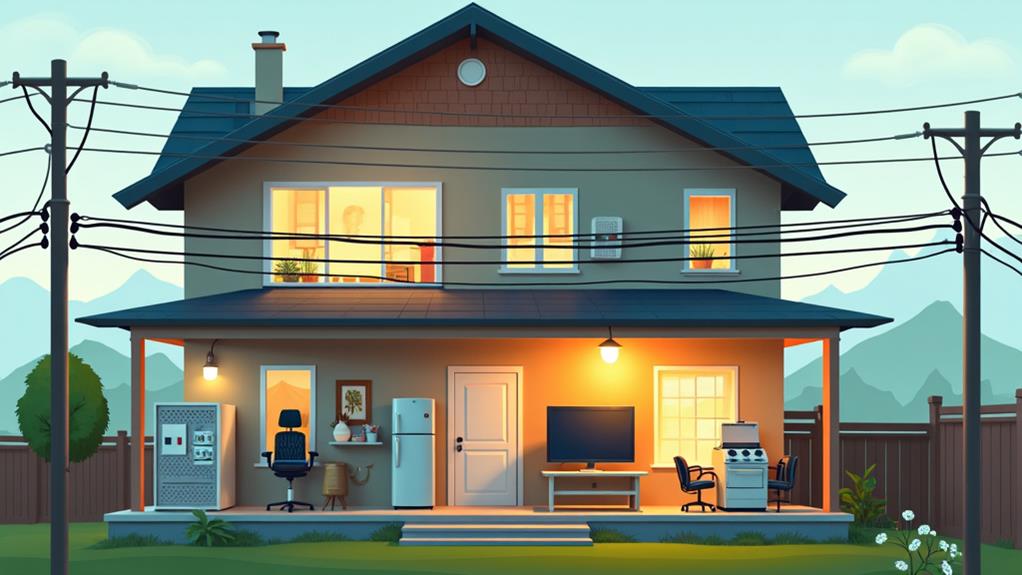What Type of Electricity Is Used in Homes?

Homes primarily use alternating current (AC) electricity, typically at 120V and 240V with a frequency of 60Hz, for efficient power distribution over long distances. But why is AC the standard, and how does it benefit daily life? The design of electrical outlets, with their distinctive prong configurations, is part of a complex and essential system. Understanding this system can help you appreciate its importance in your home.
Understanding Household Power
Understanding household power is essential for comprehending everyday electrical systems. In most U.S. homes, the standard type of electricity used is alternating current (AC). Residential power systems rely on AC because it efficiently distributes electricity over long distances and can be easily transformed to different voltage levels.
Typically, homes use 120V and 240V AC at a frequency of 60Hz. These voltage levels are necessary for powering a range of household appliances and devices. You can identify AC power in your home by looking at standard electrical outlets, which usually have two flat prongs and one round prong. These outlets are designed to safely deliver AC electricity to your devices.
The infrastructure established over decades has rooted AC as the preferred type of electricity for residential applications. Incandescent light bulbs, for example, operate on AC power, demonstrating its widespread use. While direct current (DC) is common in batteries and some electronics, AC remains the backbone of residential electrical systems due to its versatility and efficient transmission capabilities. Understanding these basics helps you better appreciate the electrical systems that power your home every day.
Identifying Your Home's Power
Understanding the type of electricity in your home is crucial. Most US homes utilize alternating current (AC) power, typically operating at 120V or 240V. Here are steps to verify this:
- Check Your Light Bulbs: Incandescent bulbs generally indicate AC power usage.
- Inspect Electrical Outlets: Standard AC outlets have two flat prongs and a round prong. Older versions might only have two flat prongs, which also suggest AC power.
- Examine Circuit Breakers or Fuse Box: Look for any labels indicating DC (direct current). This is uncommon in residential settings but would confirm the presence of DC power if found.
- Use a Multimeter: Set to measure voltage and test an electrical outlet. A reading of 120V or 240V confirms AC power. This tool provides definitive proof of your home's electrical system.
Benefits of AC Power

The advantages of AC power in residential settings are numerous and significant. A key benefit is its ability to transmit electricity over long distances with minimal energy loss, achieved through the use of transformers. This capability ensures that electricity generated far from your home can reach you efficiently, maintaining consistent power levels and reducing costs.
AC power is ideally suited for household appliances, accommodating common voltage levels of 120V and 240V. This versatility allows it to power everything from refrigerators to washing machines without requiring complex conversion systems.
Additionally, AC power is compatible with AC induction motors, which are simpler and more reliable than DC motors. These motors are common in many household devices, offering efficient and dependable operation.
Historically, the development of electrical infrastructure has favored AC power, making it the standard for residential electricity. This standardization simplifies the integration of new appliances and systems into your home, as they are designed to work seamlessly with existing AC power setups. In summary, AC power's efficiency, versatility, and reliability make it the optimal choice for residential use.
Converting Power Systems
Converting power systems involves understanding both AC (Alternating Current) and DC (Direct Current) electricity. While most residential homes use AC power, many renewable energy sources such as solar panels and wind turbines generate DC electricity. To incorporate these renewable energy sources into your home's AC power supply, a DC-to-AC converter, also known as an inverter, is necessary. These converters are widely available at hardware stores and online, making them accessible for most homeowners.
Here's a concise guide to assist you in the conversion process:
- Identify Voltage Levels: DC systems typically operate at voltages like 5V, 12V, and 24V, whereas AC systems usually operate at 120V or 240V. Understanding these voltage levels is crucial for safe and efficient conversion.
- Use a DC-to-AC Converter (Inverter): These devices convert the DC electricity from renewable sources to AC power, allowing seamless integration into your home's electrical system.
- Consult an Electrical Engineer: For customized power solutions, an electrical engineer can enhance the efficiency and reliability of your system. They can design a tailored solution that effectively balances AC and DC power.
Ensuring Power Reliability

Ensuring power reliability in your home begins with understanding the common causes of electrical failures. Issues such as overloading circuits, excessive heat, aging infrastructure, and environmental factors like humidity and dust can compromise your power supply. Regular maintenance and the use of monitoring systems are essential to predict and prevent failures before they occur.
A reliable power supply is crucial, particularly if you have sensitive equipment like medical devices that require consistent power to avoid serious consequences. Implementing redundant power supplies ensures that backups are ready to activate if your primary source fails. Additionally, Uninterruptible Power Supplies (UPS) can protect your home against power surges and outages, offering an extra layer of security.
Regular testing and maintenance of your electrical systems significantly reduce the risk of power supply issues. Make it a habit to check your circuits, replace aging components, and clean areas prone to dust and humidity. By staying proactive, you ensure your home's power remains dependable, keeping your household safe and your devices running smoothly.




